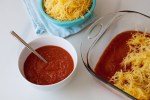Those celebrating the holiday of Passover can rejoice: you’ve made it halfway through the holiday eating one food group–Matzah.
With a few days left, here are some snack and meal ideas to change it up.
Healthy 2-ingredient pancakes

Gosh I just love these pancakes, and I make them year-round. They are fluffy, sweet, yummy, and nutritious. Best of all, they’re made of two natural ingredients: bananas and eggs. There’s no reason to save these for breakfast: with protein, fiber, potassium, and other vitamins and minerals, these are great for lunch and dinner, too.
The recipe is simple: Mash 1 ripe banana and whisk two eggs. Mix eggs and banana together and fry away, just as you would any pancake. I sometimes add 1/4 tsp vanilla for flavor (and you can also add chocolate chips, or whatever you enjoy in your pancakes). Easy? Yes! By the way, they’re so sweet they don’t need a topping, but we enjoy adding honey and berries.
Fish (or eggs) in a boat
Again, a year-round favorite. This is basically a substitute for wraps and sandwiches. Wash a romaine leaf and fill it with tuna fish salad, egg salad, babaganoush, guacamole, or whatever your kids enjoy. That’s it. I usually cut off the leafier top part, because my kids enjoy the crunchiness from the bottom half of the leaf.
Cauliflower rice

These days, you can find riced cauliflower in a bag at Trader Joe’s or make it yourself using a food processor. Cauliflower rise is simply a cauliflower minced up into rice-sized morsels. A simple sauté in oil with onions, plus some salt and your favorite spices is all you need to make this yummy. Add herbs and a squeeze of lemon juice if you so choose. If you want a specific recipe, this one is simple and great.
Spaghetti squash
 I totally convinced my kids that spaghetti squash was actually a form of spaghetti. This is yet another easy, healthy option. I cut a spaghetti squash in half, remove the seeds, drizzle on some oil, and roast at 425 degrees (flesh-side down) until tender (usually about 30-45 minutes). Remove from oven and scoop out the flesh, which will come out like spaghetti.
I totally convinced my kids that spaghetti squash was actually a form of spaghetti. This is yet another easy, healthy option. I cut a spaghetti squash in half, remove the seeds, drizzle on some oil, and roast at 425 degrees (flesh-side down) until tender (usually about 30-45 minutes). Remove from oven and scoop out the flesh, which will come out like spaghetti.
Then, all you gotta do is add tomato sauce like you would on pasta, spices to taste (I add garlic), and you can top with shredded mozzarella or Parmesan cheese (which you can melt for 30-60 seconds in the microwave. Done, nutritious, and yummy! If you want to get fancier and cheesier, here’s a riff on baked ziti using spaghetti squash!
Healthy chips
Healthy chips do exist. Don’t forget these year-round goodies. Kale chips (or try spinach chips–make them the same way you would kale chips) are awesome. Also, try to make chips with your favorite fruit, like these banana chips, which you can also do with strawberries or apples. The key with fruit chips is to keep the oven on a very low temperature, around 200 degrees, simulating a dehydrator. (Of course, if you have a dehydrator that is kosher for passover, use that instead!).










